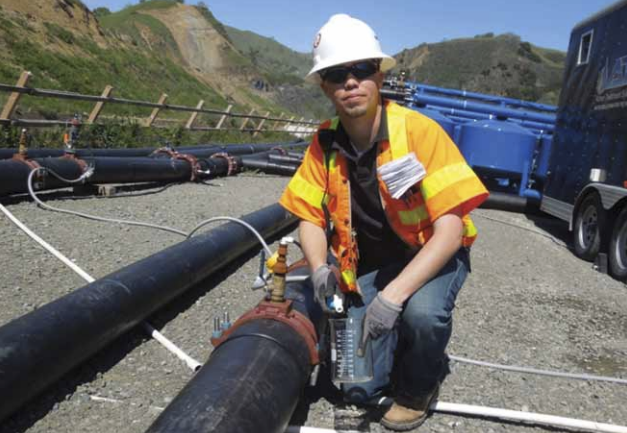Safety & Environment
All New Flatiron Projects to Have Environmental Management Plans

In early May, a group of Flatiron Construction’s operations, environmental and safety professionals met for two days to discuss what the new ISO 14001, the international certification for environmental management, really means for Flatiron.
First, being ISO 14001 certified lowers Flatiron’s risk because it improves our environmental compliance on projects. When
owners know that we have a system in place, they have a high degree of confidence that Flatiron is doing the “right thing.”
“It also saves our clients hard dollars because they don’t have to spend the time and resources on inspectors to check and recheck our work,” says environmental manager Dan Lowery. “This certification means we already have a third-party verification system in place, a sort of environmental quality control.”
Maintaining this certification also means that Flatiron will continuously improve our environmental program, ensuring we are the best of the best when it comes to the environment. The standards required by this certification provide a systematic way to measure environmental performance through leading indicators and force us to be objective and consistent. By continuously improving, Flatiron also significantly lowers the probability of violations, litigation and disputes, resulting in higher profits.
Lastly, and maybe the most obvious, we are doing this to make sure we aren’t harming the environment. “Let’s not lose sight of the fact that environmental stewardship is one of our core areas of social responsibility,” notes Dan.
Implementing a Company-Wide Environmental Program
The committee’s main objective was to determine how to best implement the environmental management system on which the certification is based. Arguably one of the most important aspects of this system is how we are actually executing it at our projects. As part of the certification process, Flatiron implemented environmental management plans on two projects—the BART Oakland Airport Connector and the Calaveras Dam. The environmental plans on these projects passed an independent audit and helped Flatiron become ISO 14001 certified.
“Our environmental systems are compliant. That’s what the certification tells us,” says Dan. “But do we know how these systems are being implemented across the company? We don’t, and that’s what the next steps are for us as a company, to identify any gaps between what we say we do and what we are actually doing.”
Who Will be Responsible for Implementing the Plans?
Another major step in the certification process is to identify and communicate responsibilities in the areas of environmental management. Flatiron does not expect to have environmental managers on every project, so who will be executing these plans?
“Just like every job does not require a dedicated quality manager, we don’t necessarily have to have dedicated environmental managers on each project. We will, however, provide resources and training for people who are interested in stepping up and taking on new responsibilities in environmental management. This could be a great career opportunity for people who are interested,” says vice president of Environmental, Health and Safety Rodney Oliver.
While the environmental management system may seem new to many employees at Flatiron, we are already meeting some of its requirements. “The beauty of the EMS is that owners’ plans already require what our system requires. We have to do a little bit of coordinating to make sure we are doing it and then checking that what we say is happening is actually happening,” says environmental manager Jason Phillips, who helped lead the implementation of an environmental plan on the Calaveras Dam project in Northern California.
“The important thing to remember is that we are already required to do these things per our contracts. It would be rare that we have an owner that doesn’t require an environmental plan.”
With environmental plans already completed and in process at the BART Oakland Airport Connector and Calaveras Dam projects, Flatiron will now make sure we are following the EMS on every project.
One of the main goals of the EMS is to ensure compliance with all environmental regulations and just as important, to make sure we are continuously improving these systems by planning, doing, checking and acting. Implementing and ensuring compliance with environmental standards, and eventually shifting the focus to leading indicators, doesn’t happen quickly. It has taken approximately 10 years for the industry to adopt safety as part of its culture. However, more emphasis on the environment is coming, and Flatiron will continue to lead the way.
